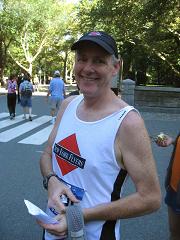Here's a quote: "
BILL MORGAN, an emeritus professor of kinesiology at the University of Wisconsin, likes to tell the story, which he swears is true, of an Ivy League pole vaulter who held the Division 1 record in the Eastern region.
His coaches and teammates, though, noticed that he could jump even higher. Every time he cleared the pole, he had about a foot to spare. But if they moved the bar up even an inch, the vaulter would hit it every time. One day, when the vaulter was not looking, his teammates raised the bar a good six inches. The man vaulted over it, again with a foot to spare.
When his teammates confessed, the pole vaulter could not believe it. But, Dr. Morgan added, “once he saw what he had done, he walked away from the jumping pit and never came back.”
After all, Dr. Morgan said, everyone would expect him to repeat that performance. And how could he?"
What a story! The head game is huge for runners. I would say that it is an even bigger differentiator for amateurs like myself than it is for professionals. Why? Well, the pros have complete clarity about commitment. Three miles into a 10K (6.2 miles), amateurs have to ask themselves "do I really want to keep up this level of exertion (pain) for another 3.2 miles?" The questions of "can I do it?" and "do I want to do it?" become blurred. We often hear the advice: "don't go out too fast", even for middle distance races. This can easily turn into an excuse for backing off when you start to feel tired.
For longer races, however, this doesn't work for me. I can only "hang on" for so long. If I'm doubting my pace a third of the way through a half marathon, I'm in trouble. So where is the line drawn between a shorter and a longer race? Right now, it seems to be at the 10K distance. I can treat a 10K as a short race, but it ain't easy, and anything longer is another story.





No comments:
Post a Comment